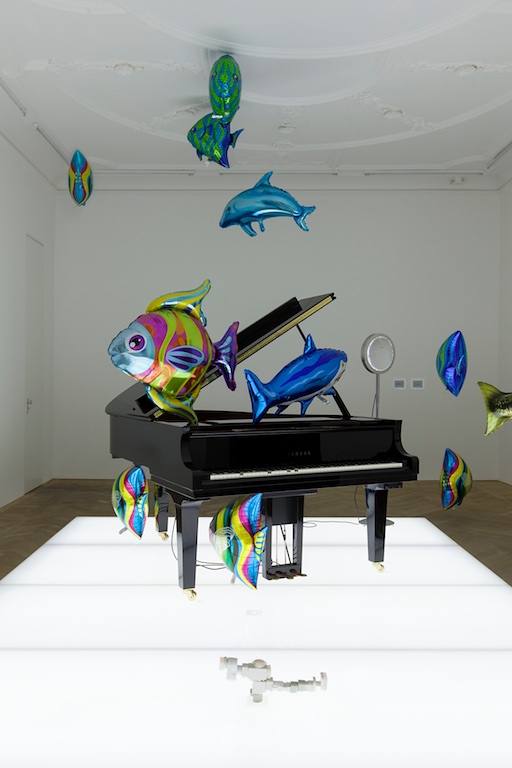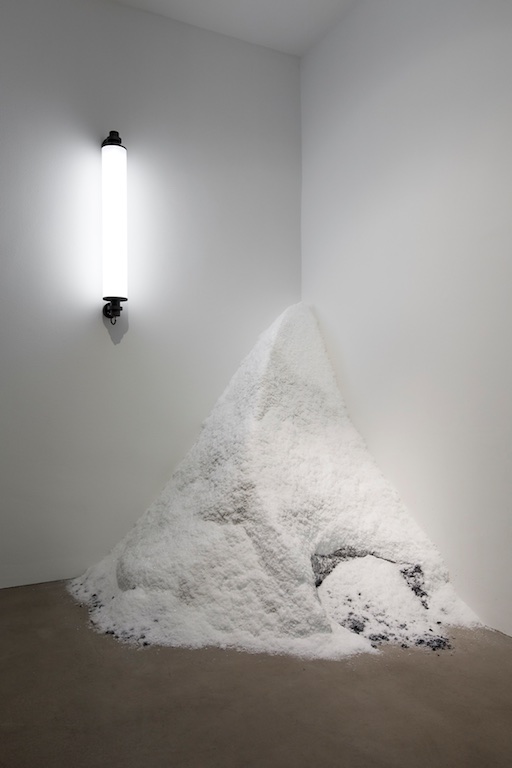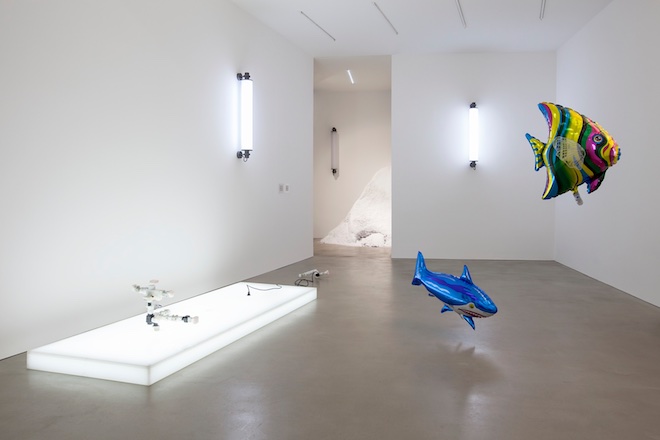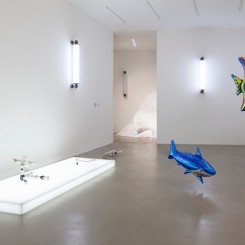by Chris Moore
Philippe Parreno, “Quasi-Objects” and “How Can We Tell the Dancers from the Dance”
Esther Schipper (Schöneberger Ufer 65, Berlin) Nov 14 – Jan 15, 2015
Schinkel Pavillon (Oberwallstrasse 1, Berlin) Nov 15 – Dec 21, 2014
In the moment before realization, between heartbeats and thoughts, vision stutters. A momentary, epileptogenic psychosis interrupts interpretation and understanding. Confusion and cognizance collide; memory and imagination entwine. “Reality” and “art” are indistinguishable. It is here, in this space, that artists like Philippe Parreno and Pierre Huyghe operate, conjuring half-familiar ghosts at the periphery of vision.
Fake snow is heaped in a corner—a mélange of polymer, diamond powder (carbon) and clay. Helium-filled colored reef fish swim randomly through the gallery space recalling Warhol’s metallic “Silver Clouds” (1966) and standing in for Cage’s “musicircus”, whereby musicians would move around and interact with a space, playing different pieces of music (whimsically at the expense of Jeff Koons). A cluster of light box signs, naked of advertising, flash apparently intermittently but actually in sync with the gallery’s ceiling strip lighting and other wall-mounted lights of a seemingly anachronistic design, and a 1958 floor lamp by Danish designer Arne Jacobsen. (1) Wall labels light up and fade. A robotic Disklavier piano plays, in time with the lights, on a light-box plinth. Another light-box supports clusters of international electrical adaptors, connected—adapting—to each other but not to the power. The windows, covered with a semi-transparent film, offer a diffuse view of “outside”.

Philippe Pareno, “Quasi Objects: My Room is a Fish Bowl, AC/DC Snakes, Happy Ending, Il Tempo del Postino, Opalescent acrylic glass podium, Disklavier Piano”, various helium inflatable float balloons in the shape of fish, electrical plugs and adapters, lamp with Arne Jacobsen lampshade, electrical system, electrical wire and plug, magnifying glass, opalescent acrylic glass podium, LED lights, 6 plugs, 194,5 x 600 x 300 cm, 2014 (image courtesy the artist and Esther Schipper, Berlinl Photo © Andrea Rossetti)
Parreno’s new exhibition at Esther Schipper gallery ostensibly presents a type of retrospective of select works dating from 1992. The exhibition title “Quasi-Objects” refers to concepts developed by philosophers Michel Serres and Bruno Latour regarding a re-contextualization of the interaction of science, taxonomies and language—particularly in Latour’s notion of the “Parliament of Things”. Put simplistically, Latour argues that the agency of objects has been ignored and deprived by language’s assumption of arbitrary classification, whereas in fact all objects exist in relation to one another as a shifting discourse, our nominal categorization of them in fact producing hybrid-concepts that are independent elements of discourse in themselves, rather than simply passive designations and taxonomies. Latour says: “Quasi-objects are much more social, much more fabricated, much more collective than the ‘hard’ parts of nature.” (2) Inevitably this has been criticized (3) but as a conceptual/creative tool for artists to steal, it has been revolutionary, allowing them to raid a completely new larder of metaphors.
What takes place in Parreno’s “Quasi-Objects” is a reincarnation and unification, indeed “liberation”, of a selection of Parreno’s works, all within the specific exhibition space at Esther Schipper gallery: creating new hybrids via environment and interbreeding of already-hybrid beasts. Accordingly, Parreno’s exhibition should be understood as a medium in its own right—one that is in flux. Different threads may be followed.

Philippe Pareno, “Marquee (cluster)”, 56 neons, 20 transformers, 132 light bulbs, 8 sound transducers, sound amplifiers, microphones, computer, soundcard, 2,154 cm x 2,167 cm x 1,190 cm, 2014
“Flickering Light” LED light, 1 programmed chip, 120 x 20,5 x 15,5 cm, 2013
(image courtesy the artist and Esther Schipper, Berlin; Photo © Andrea Rossetti)
To illustrate, consider some connections to Stanley Kubrick’s “2001: A Space Odyssey” (1968), an adaptation of science fiction writer Arthur C. Clarke’s 1951 short story “The Sentinel”. The film’s plot revolves around the attempt to discover the meaning and purpose of certain disruptive oblong monoliths, which at least one critic, the semi-respectable Rob Ager, argues represents a film screen. If so, we are once again in the cave with Plato’s prisoners/patients/lab rats. The monoliths appear in various scenes but most importantly for present purposes in the “Beyond the Infinite” scene, where a (perhaps prematurely) aging astronaut, Dr David Bowman, wanders through an hermetic bedroom and bathroom suite—presumably in the space station—projected by the spaceship’s sentient computer, HAL. The rooms are furnished with anachronistic “fake” baroque furniture offset against clinical minimalist walls, light-box floor and round spaceship escape-pod. Parreno’s Disklavier piano installation invokes 2001 stylistically (it is installed in a room with a nineteenth-century decorative stucco ceiling with the light box plinth) but also thematically, the fish appropriating the gallery space as space-ship, floating through the aquarium/gallery like the astronauts through the space-station. The piano is HAL. And the lamp? It was designed by the Danish architect and designer, Arne Jacobsen, for Scandinavian Airlines System’s SAS Royal Hotel in Copenhagen, built between 1956 and 1960. Formally, the hotel’s architecture bears a surprising resemblance to the monolith in 2001 (the cutlery Jacobsen also designed for the hotel is used by the astronauts in 2001). The adaptors eerily resemble the spacecraft displayed following the famous cutaway from the bone thrown by an ape up into the sky. (By placing the adaptor-sculptures on the light-boxes, Parreno creates a new “cutaway” by inserting them into the “inside” of the spaceship.) The Disklavier piano plays “Nuages Gris” (1881) by Franz Liszt, which was used in Kubrick’s “Eyes Wide Shut” in 1999 for a scene in which Tom Cruise kisses a corpse in a morgue.(4)

Philippe Pareno, “Snow Drift”, artificial snow, diamond powder, clay, 180 x 185 x 185 cm, 2014 (Courtesy the artist and Esther Schipper, Berlin; Photo © Andrea Rossetti)
It is equally easy to run down “paths of inquiry”—and rabbit holes. So much of Parreno’s work has focused on the viewer’s “perspective” vis-à-vis the object, particularly film work, including “June 8, 1968” (2009), a reenactment of the train journey taking the body of U.S. presidential candidate Robert F. Kennedy from New York to Washington as seen from the perspective of the corpse; “Marilyn” (2012), invoking the actress as a ghost seen via her former possessions; and even “Zidane: a 20th Century Portrait” (2006), with fellow artist and film-maker Douglas Gordon, which follows the enigmatic French football star through a match edited with his voiceover thoughts. Importantly, the “perspective” is always uncertain and shifting—however familiar we think we are with the “objects”. Parreno creates a stage for evolution—of objects and subjective thinking—as experience, and pleasure. What initially appear “real” are products of a transubstantiation of notions, existing among a number of relations in play, deliberately and coincidentally. Ultimately how we understand the mise-en-scène is a matter of perspective. Yet understanding here is shadowed by the potential for obsession and paranoia—succumbing to delusion, seeing connections where none exist (amusingly, the scientific term “Apophenia” for this behavior also dates from 1958). The object is always a little bit schizophrenic. (5) Perhaps we should take Slavoj Žižek’s advice after all, and learn to enjoy our symptoms. Now, is Jack Torrence about to slump into the Parreno’s snow, or spring out of it?

Philippe Pareno, “AC/DC Platform” (main work, installation view), opalescent acrylic glass podium, LED lights, 3 plugs, 2 AC/DC Snakes, 2013 (image courtesy the artist and Esther Schipper, Berlin; Photo © Andrea Rossetti)
Also on show in Berlin is Parreno’s “How Can We Tell the Dancers from the Dance” at the tiny Schinkel Pavilon art space near the former royal boulevard of Unter den Linden, which connected the Brandenburg Gate and the successively demolished imperial Berlin Palace and proletarian Palast der Rupublik of the GDR. (6) A homage to American choreographer, Merce Cunningham (1919-2009), long-term partner of composer John Cage (1912-1992), the installation was first shown in two Duchamp-focused exhibitions, in 2012 in “Dancing Around the Bride” at the Philadelphia Museum of Art and in 2013 in “The Bride and the Bachelors” at London’s Barbican Art Gallery, which also included Parreno’s Disklavier piano.(7) A pristine white round stage invites visitors to stand upon it; but projected from beneath can be heard a recording of Cunningham’s dancers performing a selection of five of his pieces performed after his death: “Suite for Five” (1956), “Rain Forest” (1968), “Duets” (1980), “Roaratorio” (1983), and “XOVER” (2007). Meanwhile, a curved wall moves around the stage, obscuring views through the windows, including of Unter den Linden and the Schloss Berlin construction site. The palace is being rebuilt. We might think of them—each one—as historical space stations, inevitable ruins. The disembodied beat of the dancers seems more present. The ghosts can be heard, even in space.
Notes
1. Jacobson designed the lamp for the Louis Poulson company for a commission by the Swedish hotel chain, SAS Royal Hotel, Copenhagen.
2. Latour, We Have Never Been Modern, (English translation: 1993) Harvard University Press, p.55.
3. See, for example, John Ashton, “We Have Never Been Modern (Review)” academia.edu, January 10, 2013
4. Here from a recording by French pianist Mikhail Rudy rather than the recording by Dominic Harlan used for the film.
5. Klaus Conrad, Die beginnende Schizophrenie. Versuch einer Gestaltanalyse des Wahns (Stuttgart: Georg Thieme Verlag, 1958).
6. Berlin Palace (Stadt Schloß) (1451-1950) was heavily bombed in the second world war, and finally secretly demolished with explosives by the Communist government in 1971; this was replaced by the Palast der Republic (1976-2008), itself demolished after the fall of the Berlin Wall in 1989, and now being replaced by a new Berlin Palace with a fake façade of the old palace.
7. See the astute review by Jeremy Miller “The Bride and the Bachelors and Robert Rauschenberg” in Frieze magazine, Issue 155, May 2013. The other bachelors in this case being fellow artists Jasper Johns and Robert Rauschenberg, from Black Mountain College (1933-1957, North Carolina, USA).

